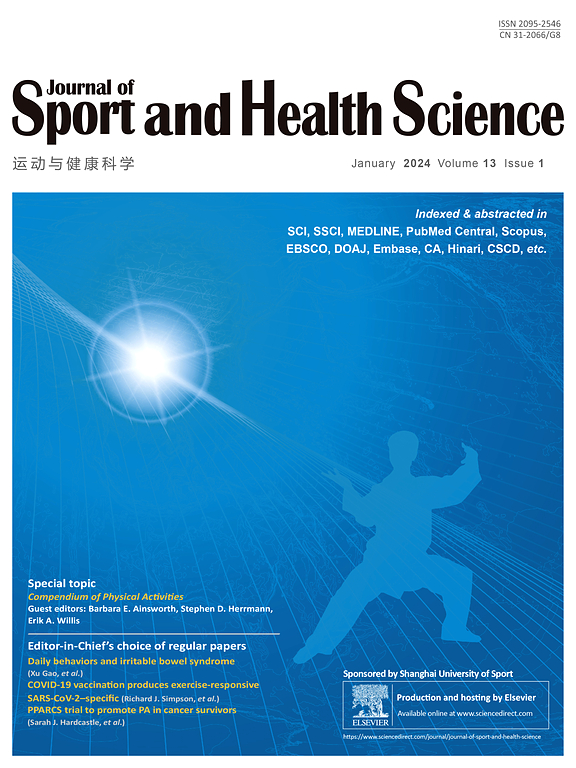Triggering sarcomerogenesis: Examining key stimuli and the role attributed to eccentric training -Historical, systematic, and meta-analytic review.
IF 10.3
1区 医学
Q1 HOSPITALITY, LEISURE, SPORT & TOURISM
引用次数: 0
Abstract
BACKGROUND Serial sarcomere number (SSN) critically influences muscle function and is hypothesized to protect against injury. While most evidence for SSN addition comes from non-human animal studies, eccentric exercise is often proposed as a key stimulus due to its association with increased fascicle length in humans. However, the most efficient exercise stimuli and the effectiveness of eccentric training in increasing SSN remain unclear. The objective of this study was to provide a detailed historical overview of research exploring the mechanical factors regulating muscle/fiber length and its relationship with function, and to explore more recent evidence that eccentric muscle contractions might be an important stimulus for SSN regulation using a meta-analytic approach. METHODS An extensive literature search with snowballing was conducted to build the historical review. A systematic review with random-effect meta analyses was performed to compare proposed types of fiber-lengthening exercises to control conditions. RESULTS The historical review demonstrated that the application of forces at long fiber lengths, but not specifically the use of greater excursions, plays an important role in increasing SSN. Animal data showed changes in SSN exceeding 20% over several weeks with varied forms of activities. Nonetheless, the meta-analysis revealed a lack of effect of eccentric resistance training in animal models (Δ = 1%; Cohen's d = 0.19 (-0.29, 0.67), p = 0.449). CONCLUSION High active or passive muscle forces applied at long fiber lengths appear to be the key stimuli triggering sarcomerogenesis. Eccentric exercise does not seem to be a key promoter of SSN. Too few studies exist to draw conclusions as to the effect of eccentric exercise on SSN in humans. Understanding the mechanical triggers and physiological mechanisms involved in serial sarcomere addition could help in the development of exercise (and other) interventions to optimize muscle function and reduce injury risk.触发肉瘤发生:检查关键刺激因素和归因于偏心训练的作用-历史,系统和荟萃分析综述。
背景:系列肌节数(SSN)对肌肉功能有重要影响,并被认为可以保护肌肉免受损伤。虽然大多数关于SSN增加的证据来自非人类动物研究,但离心运动通常被认为是一种关键的刺激,因为它与人类肌束长度增加有关。然而,最有效的运动刺激和偏心训练对增加SSN的有效性仍不清楚。本研究的目的是提供详细的研究历史概述,探索调节肌肉/纤维长度的机械因素及其与功能的关系,并利用元分析方法探索最近的证据,证明偏心肌肉收缩可能是SSN调节的重要刺激因素。方法采用滚雪球法广泛查阅文献,建立历史回顾。采用随机效应荟萃分析进行系统评价,比较建议的纤维延长运动类型与对照条件。结果历史回顾表明,在长纤维长度上施加力,而不是特别使用更大的偏移,在增加SSN中起重要作用。动物数据显示,在不同形式的活动中,SSN在几周内的变化超过20%。尽管如此,荟萃分析显示偏心阻力训练在动物模型中缺乏效果(Δ = 1%;Cohen’s d = 0.19 (-0.29,0.67),p = 0.449)。结论在长纤维处施加的高主动或被动肌力可能是引发肌肉增生的关键刺激。古怪的运动似乎不是SSN的关键促进因素。关于偏心运动对人类SSN的影响的研究太少了。了解一系列肌节增加的机械触发和生理机制有助于运动(和其他)干预的发展,以优化肌肉功能和降低损伤风险。
本文章由计算机程序翻译,如有差异,请以英文原文为准。
求助全文
约1分钟内获得全文
求助全文
来源期刊

Journal of Sport and Health Science
SPORT SCIENCES-
CiteScore
18.30
自引率
1.70%
发文量
101
审稿时长
22 weeks
期刊介绍:
The Journal of Sport and Health Science (JSHS) is an international, multidisciplinary journal that aims to advance the fields of sport, exercise, physical activity, and health sciences. Published by Elsevier B.V. on behalf of Shanghai University of Sport, JSHS is dedicated to promoting original and impactful research, as well as topical reviews, editorials, opinions, and commentary papers.
With a focus on physical and mental health, injury and disease prevention, traditional Chinese exercise, and human performance, JSHS offers a platform for scholars and researchers to share their findings and contribute to the advancement of these fields. Our journal is peer-reviewed, ensuring that all published works meet the highest academic standards.
Supported by a carefully selected international editorial board, JSHS upholds impeccable integrity and provides an efficient publication platform. We invite submissions from scholars and researchers worldwide, and we are committed to disseminating insightful and influential research in the field of sport and health science.
 求助内容:
求助内容: 应助结果提醒方式:
应助结果提醒方式:


